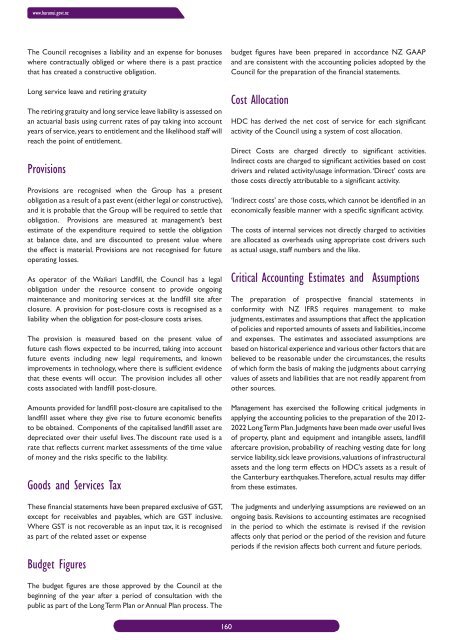Long Term Community Plan 2012-2022 - Hurunui District Council
Long Term Community Plan 2012-2022 - Hurunui District Council
Long Term Community Plan 2012-2022 - Hurunui District Council
Create successful ePaper yourself
Turn your PDF publications into a flip-book with our unique Google optimized e-Paper software.
www.hurunui.govt.nz<br />
The <strong>Council</strong> recognises a liability and an expense for bonuses<br />
where contractually obliged or where there is a past practice<br />
that has created a constructive obligation.<br />
<strong>Long</strong> service leave and retiring gratuity<br />
The retiring gratuity and long service leave liability is assessed on<br />
an actuarial basis using current rates of pay taking into account<br />
years of service, years to entitlement and the likelihood staff will<br />
reach the point of entitlement.<br />
Provisions<br />
Provisions are recognised when the Group has a present<br />
obligation as a result of a past event (either legal or constructive),<br />
and it is probable that the Group will be required to settle that<br />
obligation. Provisions are measured at management’s best<br />
estimate of the expenditure required to settle the obligation<br />
at balance date, and are discounted to present value where<br />
the effect is material. Provisions are not recognised for future<br />
operating losses.<br />
As operator of the Waikari Landfill, the <strong>Council</strong> has a legal<br />
obligation under the resource consent to provide ongoing<br />
maintenance and monitoring services at the landfill site after<br />
closure. A provision for post-closure costs is recognised as a<br />
liability when the obligation for post-closure costs arises.<br />
The provision is measured based on the present value of<br />
future cash flows expected to be incurred, taking into account<br />
future events including new legal requirements, and known<br />
improvements in technology, where there is sufficient evidence<br />
that these events will occur. The provision includes all other<br />
costs associated with landfill post-closure.<br />
Amounts provided for landfill post-closure are capitalised to the<br />
landfill asset where they give rise to future economic benefits<br />
to be obtained. Components of the capitalised landfill asset are<br />
depreciated over their useful lives. The discount rate used is a<br />
rate that reflects current market assessments of the time value<br />
of money and the risks specific to the liability.<br />
Goods and Services Tax<br />
These financial statements have been prepared exclusive of GST,<br />
except for receivables and payables, which are GST inclusive.<br />
Where GST is not recoverable as an input tax, it is recognised<br />
as part of the related asset or expense<br />
Budget Figures<br />
budget figures have been prepared in accordance NZ GAAP<br />
and are consistent with the accounting policies adopted by the<br />
<strong>Council</strong> for the preparation of the financial statements.<br />
Cost Allocation<br />
HDC has derived the net cost of service for each significant<br />
activity of the <strong>Council</strong> using a system of cost allocation.<br />
Direct Costs are charged directly to significant activities.<br />
Indirect costs are charged to significant activities based on cost<br />
drivers and related activity/usage information. ‘Direct’ costs are<br />
those costs directly attributable to a significant activity.<br />
‘Indirect costs’ are those costs, which cannot be identified in an<br />
economically feasible manner with a specific significant activity.<br />
The costs of internal services not directly charged to activities<br />
are allocated as overheads using appropriate cost drivers such<br />
as actual usage, staff numbers and the like.<br />
Critical Accounting Estimates and Assumptions<br />
The preparation of prospective financial statements in<br />
conformity with NZ IFRS requires management to make<br />
judgments, estimates and assumptions that affect the application<br />
of policies and reported amounts of assets and liabilities, income<br />
and expenses. The estimates and associated assumptions are<br />
based on historical experience and various other factors that are<br />
believed to be reasonable under the circumstances, the results<br />
of which form the basis of making the judgments about carrying<br />
values of assets and liabilities that are not readily apparent from<br />
other sources.<br />
Management has exercised the following critical judgments in<br />
applying the accounting policies to the preparation of the <strong>2012</strong>-<br />
<strong>2022</strong> <strong>Long</strong> <strong>Term</strong> <strong>Plan</strong>. Judgments have been made over useful lives<br />
of property, plant and equipment and intangible assets, landfill<br />
aftercare provision, probability of reaching vesting date for long<br />
service liability, sick leave provisions, valuations of infrastructural<br />
assets and the long term effects on HDC’s assets as a result of<br />
the Canterbury earthquakes. Therefore, actual results may differ<br />
from these estimates.<br />
The judgments and underlying assumptions are reviewed on an<br />
ongoing basis. Revisions to accounting estimates are recognised<br />
in the period to which the estimate is revised if the revision<br />
affects only that period or the period of the revision and future<br />
periods if the revision affects both current and future periods.<br />
The budget figures are those approved by the <strong>Council</strong> at the<br />
beginning of the year after a period of consultation with the<br />
public as part of the <strong>Long</strong> <strong>Term</strong> <strong>Plan</strong> or Annual <strong>Plan</strong> process. The<br />
160

















